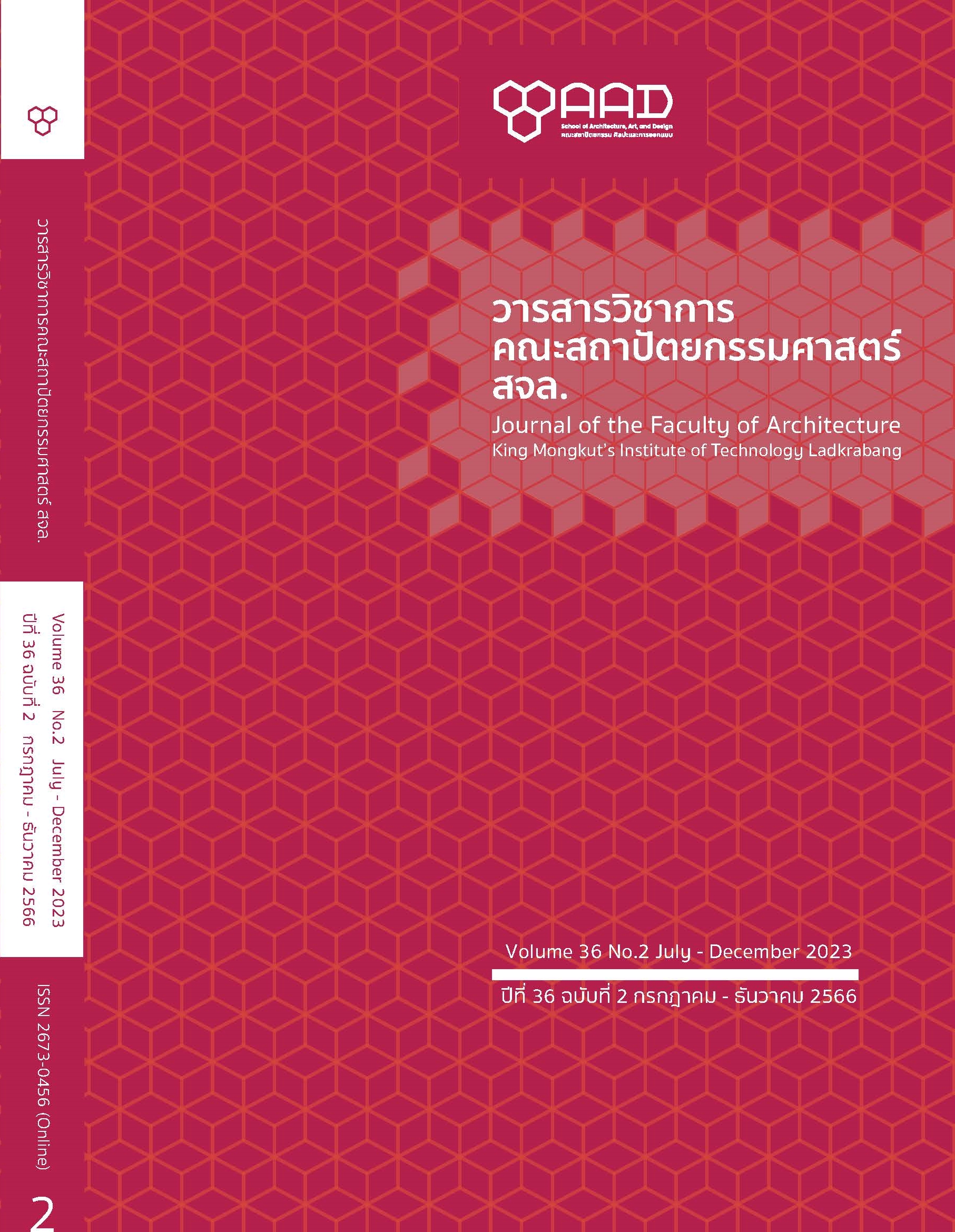A Development of Online Learning using Design Thinking Process to Promote Creativity in Packaging Design of Undergraduate Students
Main Article Content
Abstract
Objectives of the research are to 1) develop online learning management using design thinking process-based learning in the creative packaging design course; 2) promote the creativity in packaging design of learners who have learned through the instructional management developed by the researcher; 3) to study the satisfaction of learners after learning. The sampling is 15 undergraduate students enrolling in creative packaging design course, Semester 1/2022, School of Architecture, art, and design, King Mongkut's Institute of Technology Ladkrabang selected by simple random sampling technique using subjects as random units. Research instruments are 1) the interview form for teaching and learning experts 2) teaching plans and activities for teaching and learning online using the design thinking process-based learning 3) activities and media for online lessons on LMS system 4) packaging design creativity assessment form 5) student satisfaction assessment form for online teaching and learning management. The statistics used in the research are mean, standard deviation and dependent T-test. The hypothesis of the research is that after studying, students' creativity levels are higher than before studying.
The online teaching with design thinking process based is the use of design thinking techniques on a networked learning management system which has tools to facilitate students in studying and thinking Including searching for information, presenting work, and organizing online meetings. It can promote collaborative learning and develop students' creativity as well. The research findings were as follows: 1) the average index of item objective congruence (IOC) of teaching and learning activities was between 0.90-1.00, and the average index of item objective congruence of the evaluation was between 0.93-1.00, and the quality assessment result of activities and media for online lessons on the LMS system was in a very good quality ( = 4.85, S.D. = 0.33). 2) students' total creativity scores after studying were higher than before studying at a statistical significance of .05. (the average creative scores before learning were (
= 1.88, S.D. = 0.40 and the average creativity scores after learning were (
= 3.78, S.D. = 0.27). 3) The results of student satisfaction assessment toward online teaching and learning using the design thinking process-based learning were at a high level (
= 4.39, S.D. = 0.70).
Article Details

This work is licensed under a Creative Commons Attribution-NonCommercial-NoDerivatives 4.0 International License.
This work is licensed under a Creative Commons Attribution-NonCommercial-ShareAlike 4.0 International License.
Copyright Transfer Statement
The copyright of this article is transferred to Journal of The Faculty of Architecture King Mongkut's Institute of Technology Ladkrabang with effect if and when the article is accepted for publication. The copyright transfer covers the exclusive right to reproduce and distribute the article, including reprints, translations, photographic reproductions, electronic form (offline, online) or any other reproductions of similar nature.
The author warrants that this contribution is original and that he/she has full power to make this grant. The author signs for and accepts responsibility for releasing this material on behalf of any and all co-authors.
References
Amabile, T. M. (1982). Social psychology of creativity: A consensual assessment technique. Journal of Personality and Social Psychology, 43(5), 997–1013. https://doi.org/10.1037/0022-3514.43.5.997
Anderson, L. W., Krathwohl, D. R., Airasian, P. W., Cruikshank, K. A., Mayer, R. E., Pintrich, P. R., Raths, J., & Wittrock, M. C. (2001). A taxonomy for learning, teaching, and assessing: A revision of Bloom’s Taxonomy of Educational Objectives (Complete edition). Longman.
Banihashem, K., Farokhi Tirandaz, S., Shahalizadeh, M., & Mashhadi, M. (2014). The Effect of E-learning on Students’ Creativity. Interdisciplinary Journal of Virtual Learning in Medical Sciences. 5(4), 53-61.
Besemer, S. P., & Treffinger, D. J. (1981). Analysis of creative products: Review and synthesis. Journal of Creative Behavior, 15, 158-178.
Brown, T. (2008). Design thinking. Harvard Business Review. 86(6), 84–92.
Chewanon B. (2018). A development of online training using synectic techniques to enhance creative thinking for printing media design of students in bachelor’s degree program in computer graphics majoring in printing media design. [Master’s thesis, Silpakorn University]. http://ithesis- ir.su.ac.th/dspace/bitstream/123456789/2260/1/57257401.pdf (in Thai)
Goldman, S., & Kabayadondo, Z. (2016). Taking Design Thinking to School. Routledge.
Guilford, J. P., & Hoepfner, R. (1971). The Analysis of intelligence. McGraw-Hill Book Co.
Hall, B., & Khan, B. (2003). Adoption of New Technology. https://ssrn.com/abstract=410656.
Han, Forbes, J., Schaefer, H., & Dirk. (2019). An exploration of the relations between functionality, aesthetics and creativity in design. International conference on engineering design, iced19. (pp. 259-268). Delft.
Hasso Plattner Institute of Design at Stanford. (2007). Design thinking process. Stanford University.
Prabir, S., & Amaresh, C. (2007). Development of a method for assessing design creativity. International conference on engineering design, iced’07. (pp. 349-350). Paris, France.
Rojsangrat, P. (2016). Development for and instructional model using design thinking to create Thai product identity for undergraduate students. Journal of Education Studies, 48(3), 258-273. http://eresource.car.chula.ac.th/chula-ejournals/openpdf/openpdf.php?id=12726 (in Thai)
Salmon, G. (2000). E-moderating: The key to teaching and learning online. Kogan Page.
Sosa, M. E., & Marle, F. (2013). Assembling Creative Teams in New Product Development Using Creative Team Familiarity. Journal of Mechanical Design, 135(8), 081009–081013. https://doi.org/10.1115/1.4024763
Tan, C. (2016). Understanding creativity in East Asia: insights from Confucius’ concept of junzi. International Journal of Design Creativity and Innovation, 4(1), 51–61. https://doi.org/10.1080/21650349.2015.1026943
Tongkaew, T. (2020). New normal based design in education: impact of COVID-19. Journal of teacher professional development, 1(2), 1-10. (in Thai) https://ph02.tci-thaijo.org/index.php/withayajarnjournal/article/view/241830/164268
Wayo, W., Chalearnnukhul, A., Karnkayan, C., & Khonyai, J. (2020). Online teaching under the COVID-19 virus outbreak situation: concepts and applications for teaching and learning. Regional Health Promotion Center 9 Journal, 14(34), 285-298. (in Thai) https://he02.tci-thaijo.org/index.php/RHPC9Journal/article/view/242473/165778
Yalçın, V., & Erden, Ş. (2021). The effect of STEM activities prepared according to the design thinking model on preschool children's creativity and problem-solving skills. Thinking Skills and Creativity, 41. https://doi.org/10.1016/j.tsc.2021.100864
Yuan, X., & Lee, J. H. (2014). A quantitative approach for assessment of creativity in product design. Advanced Engineering Informatics, 28(4), 528-541. https://doi.org/10.1016/j.aei.2014.07.007

